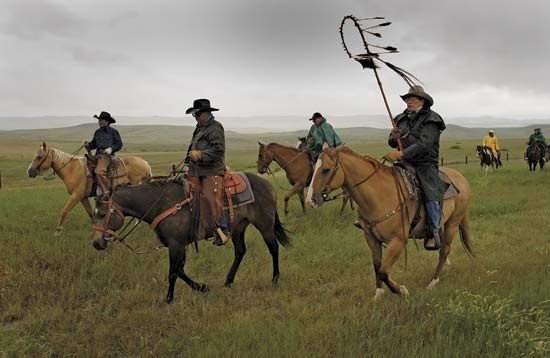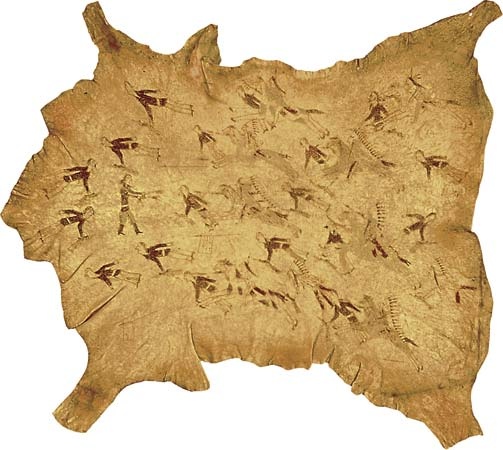Cheyenne
Wyoming, United States
capital (since 1869) and largest city of Wyoming, U.S., and seat of Laramie county, in the southeastern corner of the state, on Crow Creek, 49 miles (79 km) east of Laramie city; it sprawls over high prairie that slopes westward to the Laramie Mountains. Squatters arriving in 1867 just ahead of the Union Pacific Railroad (Union Pacific Railroad Company) named the place for the Cheyenne Indians; they were removed from the railroad's land grant by federal troops. In the 1870s the town became an outfitting point for the Black Hills goldfields to the northeast and a major shipping point for cattle from Texas. Its own grazing lands became famed for Hereford herds and wealthy cattle barons. Peopled by gunmen, gamblers, and transients, Cheyenne developed a low reputation during the days of the Vigilantes and the war between cattlemen and sheepmen.
The city is now a trade and distribution centre for the middle Rocky Mountain region. Its major economic activities include transportation, timber, livestock interests, chemicals, plastics, health care, tourism, and governmental activities. Fort D.A. Russell (1867) became Fort Francis E. Warren in 1930 and as an Air Force base was designated (1957) as headquarters for the nation's first Atlas intercontinental ballistic missile base. The State Capitol with its lantern-type cupola atop a 145-foot (44-metre) dome displays Western murals within. The Wyoming State Museum is nearby, as is the Historic Governor's Mansion. The world's largest steam engine is on display in Holliday Park. Frontier Days, featuring one of America's oldest and largest rodeos, is a six-day celebration held each July, recalling the spirit of the Wild West and the cattle kingdom days. Among the city's attractions are the Cheyenne Botanic Gardens, and the city is home to the Cheyenne Symphony Orchestra and Laramie County Community College (1968). Inc. 1867. Pop. (1990) city, 50,008; Cheyenne MSA, 73,142; (2000) city, 53,011; Cheyenne MSA, 81,607.
people
 North American Plains Indians (Plains Indian) who spoke an Algonquian (Algonquian languages) language and inhabited the regions around the Platte and Arkansas rivers during the 19th century. Before 1700 the Cheyenne lived in what is now central Minnesota, where they farmed, hunted, gathered wild rice, and made pottery. They later occupied a village of earth lodges on the Cheyenne River in North Dakota; it was probably during this period that they acquired horses and became more dependent on the buffalo for food.
North American Plains Indians (Plains Indian) who spoke an Algonquian (Algonquian languages) language and inhabited the regions around the Platte and Arkansas rivers during the 19th century. Before 1700 the Cheyenne lived in what is now central Minnesota, where they farmed, hunted, gathered wild rice, and made pottery. They later occupied a village of earth lodges on the Cheyenne River in North Dakota; it was probably during this period that they acquired horses and became more dependent on the buffalo for food.After their town was destroyed by the Ojibwa (Chippewa), the Cheyenne settled along the Missouri River near the Mandan and Arikara tribes. Toward the close of the 18th century, smallpox and the aggression of the Dakota Sioux decimated the village tribes at the same time that the horse and gun were becoming generally available in the northeastern Plains. The Cheyenne moved farther west to the area of the Black Hills, where they developed a unique version of nomadic Plains culture and gave up agriculture and pottery. During the early 19th century, they migrated to the headwaters of the Platte River in what is now Colorado. In 1832 a large segment of the tribe established itself along the Arkansas River, thus dividing the tribe into northern and southern branches. This division was recognized in the First Treaty of Fort Laramie with the United States in 1851.
Traditional Cheyenne religion focused upon two principal deities, the Wise One Above and a god who lived beneath the ground. In addition, four spirits lived at the points of the compass. The Cheyenne performed the Sun Dance in a very elaborate form. They placed heavy emphasis on visions in which a guardian spirit adopted the individual and bestowed special powers upon him or her so long as certain prescribed laws or practices were observed. Their most-venerated objects, contained in a sacred bundle, were a hat made from the skin and hair of a buffalo cow and four arrows—two painted for hunting and two for battle. These objects were carried in war to ensure success over the enemy.
Traditional Cheyenne society was organized into 10 major bands governed by a council of 44 chiefs and 7 military societies; the Dog Soldiers were the most powerful and aggressive of the military groups. There were also social, dance, medicine, and shamanistic societies; a given society was generally open to either male or female members but not to both.
 The Cheyenne fought constantly with the Kiowa until 1840, when a lasting peace was established between them. From 1857 to 1879 the Cheyenne were embroiled in raids and wars with U.S. military troops; the conflicts often caused suffering for civilians, including Cheyenne and settler women, children, and elders. The tribe began raiding emigrant settlements and military and trading posts on a wide front after the Sand Creek Massacre (1864), in which a peaceful Cheyenne village was destroyed by the U.S. cavalry. In the Treaty of Medicine Lodge (1867), the Southern Cheyenne were assigned a reservation in Oklahoma, but they settled there only after 1875. After George Armstrong Custer's (Custer, George Armstrong) attack on their Washita River village in 1868, the Southern Cheyenne were fairly peaceful until 1874–75, when they joined in the general uprisings of the southern Plains tribes. In 1876 the Northern Cheyenne joined the Dakota in the Battle of the Little Bighorn (Little Bighorn, Battle of the) and there defeated Custer.
The Cheyenne fought constantly with the Kiowa until 1840, when a lasting peace was established between them. From 1857 to 1879 the Cheyenne were embroiled in raids and wars with U.S. military troops; the conflicts often caused suffering for civilians, including Cheyenne and settler women, children, and elders. The tribe began raiding emigrant settlements and military and trading posts on a wide front after the Sand Creek Massacre (1864), in which a peaceful Cheyenne village was destroyed by the U.S. cavalry. In the Treaty of Medicine Lodge (1867), the Southern Cheyenne were assigned a reservation in Oklahoma, but they settled there only after 1875. After George Armstrong Custer's (Custer, George Armstrong) attack on their Washita River village in 1868, the Southern Cheyenne were fairly peaceful until 1874–75, when they joined in the general uprisings of the southern Plains tribes. In 1876 the Northern Cheyenne joined the Dakota in the Battle of the Little Bighorn (Little Bighorn, Battle of the) and there defeated Custer.Early 21st-century population estimates indicated more than 20,000 Cheyenne descendants.
- Fortune Theatre
- Fortune, T. Thomas
- Fort Union National Monument
- Fortuny, Mariano
- Fort Valley
- Fort Valley State University
- Fort Walton Beach
- Fort Wayne
- Fort William
- Fort William
- Fort Worth
- Fort Worth Zoological Park
- Forty Martyrs of England and Wales
- forum
- Fos
- Fosbury, Dick
- Foscari, Francesco
- Foscolo, Ugo
- Fosdick, Harry Emerson
- Foshan
- fossa
- Fossano
- Fosse, Bob
- Fossett, Steve
- Fosse Way